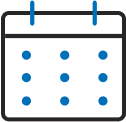Pipeline Condition Assessment
February 23-25, 2026
Irvine, CA

Pipeline Condition Assessment Seminar
Developing Water Utility Action Plans
AWWA’s three-day in-person seminar tackles the issue of pipeline condition assessment. As renewing and replacing aging infrastructure remains a top challenge facing the water sector, more utilities are embracing asset management practices, including condition assessment. A condition assessment program helps utilities make informed, risk-based decisions on when it is best to maintain, repair, rehabilitate, or replace assets.
Developing and implementing such a program is challenging. This seminar was created to assist drinking water utilities develop and implement a comprehensive condition assessment program or improve their existing program. The focus of this seminar is on water transmission and distribution pipes.
Registration
February 23-25, 2026
Irvine Ranch Water District’s Duck Club
15 Riparian View, Irvine, CA 92612
Seminar Pricing:
$635 – Member
$835 – Nonmember
Who Should Attend
Utility operations specialists
Asset managers
Utility professionals
Engineers and project managers
Consultants and contractors

Program
The seminar will assist drinking water utilities develop and implement a comprehensive condition assessment program, or improve their existing program. The focus is on water transmission and distribution pipes.
Learning Objectives
During this seminar participants will be engaged in instructional training, interactive exercises, and group sharing that will cover the key components of a condition assessment program, such as:
- Defining the problem(s) that the utility wants to solve with a condition assessment program.
- Developing condition assessment program goals, objectives, and data expectations.
- Building support and securing an annual budget for a condition assessment program (e.g., business case to present to management and elected governing officials).
- Prioritizing asset classes based on performance measures and risk (i.e., likelihood or probability and consequence of failure).
- Defining the utility’s risk tolerance and condition assessment thresholds.
- Creating a framework and data management system for collecting, storing, and using condition assessment data.
- Understanding and choosing the appropriate condition assessment methods and technologies.
- Evaluating the utility’s options for using in-house or contracting field inspection, data management, and engineering services.
Program Agenda
Module 1 – Getting Started with Your Condition Assessment Program (Day 1 — 8:30 a.m. – 4:30 p.m.)
- Learn how to establish prudent condition assessment program budgets
- Generate ideas for where to start
- Consider methods being used by other utilities to quantify and justify a program budget
- Determine which method is right for your utility
- Define desktop condition assessment
- Discuss commonly used methods for performing a desktop condition assessment
- Present different ways to estimate LOF and COF
- Discuss how break data and failure mechanisms can be used to focus condition assessment and other investments
- Discuss reasons your utility might have for not locating, assessing, and operating small and large diameter valves
- Review the critical role of valves in the water delivery system
- Address the importance of regularly scheduled condition assessment and operation of isolation/control valves
- Present key components of a valve assessment program (benefits, goals, program approaches, in-house vs. outsourcing resources, field activities, data collection/documentation, and answers to common questions and concerns)
- Discuss reasons for conducting leak detection
- Learn how and why we use leak detection as a condition assessment tool
- Introduce currently available leak detection methods and tools (acoustic and non-acoustic)
- For acoustic leak detection methods, understand how sound travels through pipes and learn about methods for distribution pipes and transmission mains
- Discuss the benefits of pressure monitoring
- Learn about currently available equipment for pressure/transient pressure monitoring
- Cover factors to consider for installing and maintaining a pressure monitoring system
- Review causes and effects of corrosion on metallic pipelines
- Understand the various corrosion tests conducted in the field and laboratory
- Understand how cathodic protection systems work
- Learn how to employ anode retrofits as a rehabilitation measure for service connections
Module 2 – Choosing Inspection Methods & Technologies to Fit Your Needs (Day 2 — 8:30 a.m. – 4:00 p.m.)
- Evaluate inspection methods and technologies for pressure pipelines
- Consider various factors when selecting an inspection method
- Choose when and how to apply external corrosion direct assessment (ECDA) methods for metallic cylinder and direct assessment methods for concrete pipe and mortar coating
- Understand deterioration processes for asbestos cement (AC) pipe and plastic pipe, including polyvinyl chloride (PVC) pipe and high-density polyethylene (HDPE) pipe
- Learn which inspection methods and technologies may be useful for non-metallic pipe
- Address and discuss reasons for employing “lower effort” inspection methods and measurements
- Review commonly used tools for metallic pipe (CI, DI, steel) and concrete pressure pipe (CCP, RCCP, PCCP)
- Cover access requirements, civil site work and field support requirements, cost, and results
- Discuss “when” and “why” you would want to use a high-resolution inspection method
- Cover methods you may be familiar with (ultrasonics, magnetic flux leakage, electromagnetics)
- Discuss electromagnetic technology (principle, tools, applicability to different pipe types, deployment options, access requirements, verification of inspection results)
Module 3 – Budgeting and Planning for Condition Assessments (Day 3 — 8:00 a.m. – noon)
- Review typical databases of record for storing condition assessment data
- Discuss and learn best practices and guidelines to identify the right database of record for your next condition assessment project
- Identity the four parties involved in contracts for pipeline condition assessment projects and programs
- Evaluate contracting options at your utility for procuring engineering, inspection, and contractor services
- Apply rules and contracting preferences at your utility to identify and select the preferred contracting mechanism(s) for YOUR utility, based on 1) availability and capabilities of in-house resources, and 2) available contracting vehicles for procuring outside services
- Increase your confidence in preparing a realistic budget for your pipeline condition assessment project
- Apply what you have learned about inspection methods, executing field inspections, and contracting options to ensure all costs are accounted for and estimated accurately
- Learn some cost-saving techniques to reduce the budget needed for your pipeline condition assessment project
- After inspection is complete, learn how to effectively communicate the value of condition assessments to 1) external or non-technical stakeholders, and 2) internal or technical stakeholders, in an effort to sustain program momentum
- Hear how other utilities have successfully justified condition assessment expenditures to management and stakeholders
- Solutions to Utility-Specific Challenges and Concerns
- Obtain answers to your specific problems, challenges, concerns, or hurdles
- Use individual projects brought to the seminar by the participants as sample problems for the group to solve
- Complete individual action plans with help from the group or facilitator
Certificates of Completion
AWWA will provide Certificates of Completion for full seminar attendance.
How to Access AWWA Certificates of Completion
Special note for Licensed Operators: Does your state require pre-approval? If so, reach out to us at at EducationServices@awwa.org for feasibility in your location.
Disclaimer: All approvals are at the discretion of your licensing agency, and a Certificate of Completion does not guarantee that your agency will award you credit. It is the individual’s responsibility to contact the licensing agency to confirm that the education program is acceptable for continuing education credit. Visit awwa.org/credits to learn more.
Please allow 30 to 60 days for certificate processing time. For certificate discrepancies or continuing education questions, email EducationServices@awwa.org.
Irvine Ranch Water District
Duck Club
The historic Duck Club building is located on the Irvine Ranch Water District’s (IRWD) San Joaquin Marsh Campus. The Campus is the embodiment of IRWD’s dedication to lifelong water education. The location provides a wide variety of educational venues and teaching opportunities utilizing IRWD’s Natural Treatment System, the Butterfly Garden, and the San Diego Creek. The Duck Club building today serves as a venue for educational trainings and meetings.
The Duck Club is located at 15 Riparian View, Irvine, CA 92612, less than five miles from the John Wayne Orange County Airport. Many hotels are located in this region, please explore options online or refer to the Irvine hotel webpage below.
Irvine Hotel & Visitors Guide
Seminar Instructors

Dave Spencer
Lead – Pipeline Asset Management Group
HDR Engineering
Read Bio

Dan Ellison
Senior Project Manager
HDR Engineering
Read Bio
Seminar Registration Cancellation Policy: AWWA must receive cancellations in writing. Phone cancellations are not accepted. All cancellations dated more than four weeks prior to seminar’s first day will receive a refund, minus a 25% administrative fee. Within four weeks of the seminar start date: cancellations will not be refunded; however, substitute registrants are welcome. Email requests for substitutions or cancellations to service@awwa.org.
